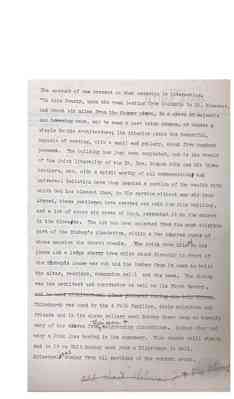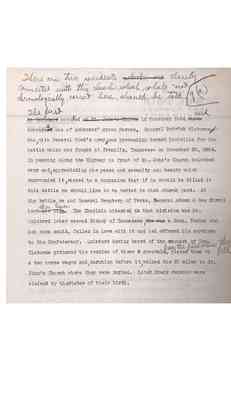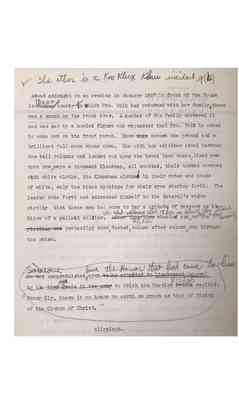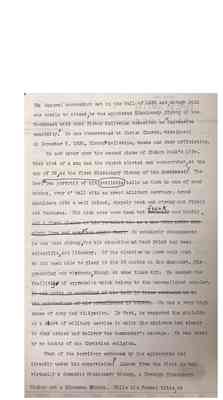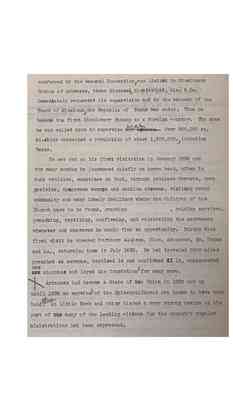Pages
11
The account of one present on that occasion is interesting: "In this County, upon the road leading from Columbia to Mt. Pleasant, and about six miles from the former place, in a grove of majestic and towering oaks, may be seen a neat brick church, of chaste & simple Gothic architecture; its intereior plain but beautiful, capable of seating, with a small end gallery, about five hundred persons. The building has just been completed and is the result of the joint liberality of the Rt. Rev. Bishop Polk and his three brothers, who, with a spirit worthy of all commendation{struckthrough: s} and universal imitation have thus devoted a portion of the wealth with which God has blessed them, to His service without any aid from Abroad, these gentlemen have erected and paid for this building, and a lot of about six acres of land, presented it to the church in the dioce{struchthrough: a}se. The lot has been selected from the most eligible part of the Bishop's plantation, within a few hundred yards of whose mansion the church stands. /The brick were kiln{added: ed} on his place and a large cherry tree which stood directly in front of the Bishop{struckthrough: '}s house was cut and the lumber from it used to build the altar, rearidos, communion raill and the pews. The Bishop was the architect and contractor as well as its First Rector{added: .} {struckthrough: and he used architectural ideas gathered during his trip abroad.} Thischurch was used by the 4 Polk families, their neighbors and friends and in its slave gallery each Sunday there came to worship many of the slaves from {insert symbol: their own &} neighboring plantations. Bishop Otey and many a Polk lies buried in its cemetery. This church still stands and to it on Whit Sunday each year a Pilgrimage is held, Episcopal{struckthrough: s; added: ians} coming from all sections of the central south.
{struckthrough handwritten: add about Cleburne ? & Ku Klux}
12
{This first paragraph is handwritten}
There are two incidents {struckthrough: which are} closely connected with this church, which, while not chronologically correct here, should be told.
{Handwritten to the side: 9 (a)}
{Struckthrough: An incident} {Added: The first} occur{added: r}e {struckthrough: at St. John's Church} in November 1864 {struckthrough: which} {added: and} concern{struckthrough: ed; added: s} one of Arkansas' great Heroes, General Patrick Cleburne{struckthrough: ,} who{added: ,} with General Hood's army{added: ,} was proceeding toward Nashville for the battle which was fought at Franklin, Tennessee on November 30, 1864. In passing along the Highway in front of St. John's Church helooked over and{added: ,} appreciating the peace and serenity and beauty which surrounded it{added: ,} stated to a companion that if he should be killed in this battle he should like to be buried in that church yard. At the battle he and General Granbery of Texas, General Adams & Gen Strahl lost {struckthrough: his life.} {added: their lives.} The Chaplain attached to that division was Mr. Quintard later second Bishop of Tennessee{added: ,} {struckthrough: who was} a Conn. Yankee who had come south, fallen in love with it and had offered his services to the Confederacy. Quintard having heard of the request of Gen. Cleburne gathered the reamins of these 4 gneerals {added: from the field where they fell}, placed them on a two horse wagon and{added: ,} marching before it{added: ,} walked the 35 miles to St. John's Church were they were buried. Later their remains were claimed by theStates of their birth,
13
{Handwritten at top: {{checkmark}} The other is a Ku Klux Klan incident. 9 (b)}
About midnight on an evening in January 1867 in front of the House in {struckthrough: Murray} {added: Maury} county {"t" written over "w"}o {"w" written over "c"}hich Mrs. Polk had returned with her family{added: ,} there was a knock on the front door. A member of the family answered it and was met by a hooded figure who requested that Mrs. Polk be asked to come out on the front porch. Snow {illegible x-ed out} covered the ground and a brilliant full moon shone down. She with her children stood between the tall columns and looked out upon the broad lawn where{added: ,} lined row upon row{added: ,} were a thousand Klansmen, all mounted, their horses covered with white cloths, the Klansmen clothe{"d" written over "s"} in their robes and hoods of white, only the black openings for their eyes staring forth. The leader rode forth and addressed himself to the General's widow stating that these men had come to pay a tribute of respect to the Widow of a gallant soldier. {Added: He did nothing else. Then in silence, they stood for a few moments,} {Struckthrough: After that they} {added: then} wheeled and{added: ,} on the {struckthrough: yielding but} protesting snow{added: ,} dashed{added: ,} column after column{added: ,} out through the gates.
{the following paragraph is circled}
{Struckthrough: He was} {Added: Someone} congratulated {insert symbol: him} upon {struckthrough: being promoted to Lieutenant{{underlined}} General{{underlined}} {added: the Honor that had come to him} {struckthrough: to the high/est grade in the army} to which the Warrior {struckthrough: Prince} {added: Bishop} replied: {added: "}Honor Sir, there is no honor on earth so great as that of Bishop of the Church of Christ.{added: "}
clippings.
14
The General convention met in the fall of 1838 and{added: ,} though Polk was unable to attend{added: ,} he was appointed Missionary Bishop of the Southwest with what Bishop McIlvaine described as {added: "}impressive unanimity.{added: "} He was consecrated at Christ Church, Cincinnati on December 9, 1838, Bishop{added: s} McIlvaine, Meade and Otey officiating.
We now enter upon the second phase of Bishop Polk's life. What kind of a man had the church elected and consecrated{added: ,} at the age of 32{added: ,} as the first Missionary Bishop of the Southwest{period changed to question mark} The best {moved from after "pen portrait of him": available} pen portrait of him tells us that he was of good statue, over 6' tall with an erect military carriage, broad shoulders with a well poised, shapely head and strong and finely cut features. His blue eyes were keen but {struckthrough: friendly} {added: frank} and kindly{added: .} {struckthrough: and a first glance at him revealed him as a man whom noble men might love and mean{{added: er}} men might fear.} In scholarly attainments he was less strong{added: ,} for his education at West Point had been scientific{added: ,} not literary. Of the classics he knew only what he had been able to glean in his 18 months at the Seminary. His preaching was vigorous{added: ,} though at some times dry. He lacked the facilit{"y" written over "ies"} of expression which belong to the accomplished scholar. {Struckthrough: He was quite as conscious of his lack in these respects as he was unconscious of his preeminence in others.} He had a very high sense of duty and obligation. In fact, he regarded the ministry as a sort of military service in which the minister had simply to obey orders and deliver the commander's message. He was beset by no doubts of the Christian religion.
What of the territory embraced by his episcopate and directly under his supervision{period replaced by question mark} Almost from the first he was virtually a domestic Missionary Bishop, a foreign Missionary Bishop and a Diocesan Bishop. While his formal title{added: ,} as
15
conferred by the General Convention{added: ,} was limited to Missionary Bishop of Arkansas, three Diocese{added: s,} Mississippi, Ala. & La. immediately requested his supervision and at the request of the Board of Missions{added: ,} the Republic of Texas was added. Thus he became the first Missionary Bishop to a foreign country. The area he was called upon to supervise {struckthrough: was immense.} {added: was} Over 500,000 sq. mi.which contained a population of about 1,500,000.{added: ,} including Texas.
He set out on his first visitation in January 1839 and for many months he journeyed chiefly on horse back, often in rude vehicles, sometimes on foot, through pathless forests, open prairies, dangerous swamps and swollen streams, visiting every community and many lonely dwellings where the children of the Church were to be found, granting {blank space }, holding services, preaching, baptizing, confirming, and celebrating the sacrament whenever and wherever he could find an opportunity. During that first visit he covered Northern Alabama, Miss, Arkansas, So. Texas and La., returning home in July 1839. He had traveled 5000 miles preached 44 sermons, baptized 14 and confirmed {illegible x-ed out} 14, consecrated {x-ed out: new} one churche{x-ed out: s} and layed the foundation{added: s} for many more.
{Added: large X} Arkansas had become a State of the Union in 1836 but up until 1838 no service{added: s} of the EpiscopalChurch were known to have been held {added: there}. At Little Rock and other places a very strong desire on the part of {x-ed out: the} many of the leading citizens for the church's regular ministrations had been expressed.
